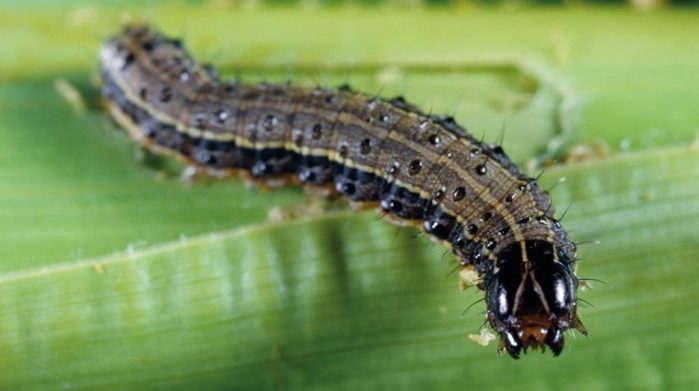By Nita Karume,
The fall armyworm is a known heavy feeder for its quick destruction of the maize crop; it has the ability to destroy an entire crop if not controlled on time. Moreover, it can spread fairly fast and can fly over 30km in one night under windy conditions. As such, its scientific name is derived from its feeding habits.
The pest is native to North and South America and Argentina. Recently, however, it was identified for the first time in West Africa before extensively spreading to Southern Africa. The fall armyworm has also been reported in parts of Togo, Nigeria, Ghana, Malawi, Zambia, Namibia, Mozambique and Zimbabwe where there have been reported damages in thousands od hectares of crops. East Africa was also not spared as emergence of the fall armyworm in Uganda was reported last month. It has also been reported to have spread to some areas of Western Kenya.
Identification
For distinction from other armyworm species, the head of the insect should be taken into account. The fall armyworm’s head has a predominantly white, inverted Y-shaped joint between the eyes. Young larvae are greenish or brownish in color and are also smooth-skinned. On the other hand, mature larvae vary from light tan or green to nearly black.
Feeding habits
Fall armyworms can feed on almost all types of plants. They prefer to feed on maize but also target other grains. The fall armyworms will take approximately 3 to 5 days for the eggs to hatch. Once hatched, the developmental time of the larval stage will go from 2 weeks to a month. Pupation occurs in the ground near the plant and usually requires 1 to 2 weeks. The adult female lays about 150 eggs a day for approximately 2 weeks. This, according to research is among the 1500 and 2000 eggs it lays in a lifetime. The worm will morph into a moth within 10-12 days. It will then proceed to move in groups with the ability to cover several kilometers in search of fresh crops to consume.
Damages
According to biology, pests that lack a threat in terms of natural enemies are usually the most destructive. The fall army worm has very few predators-if at all, and even when invading a new area there will probably be none. Furthermore, the larval stage of the fall armyworm is known to be its most destructive stage. This is because the larvae feed on maize leaves and may attack the tassels. Their damage appears as tattered edges and holes on leaves and tassels. Cases of severe feeding will leave the maize crop looking like it has been through a hail storm. It is important to note that the first attack of the fall armyworm’s invasion often goes unnoticed. This is due to the fact that the small larvae that hatch from egg burrow into plant parts. This makes them almost impossible to detect but on close observation, and by the time the larvae gets fully developed it will be too late for the plant.
Control
More often than not, people use synthetic pesticides in controlling the pest. Unfortunately, this method has proven to be harmful since the chemical sprays contaminate the environment. They are also known to result in major health risks in humans. Alternative methods include use of pheromone traps and hand picking of adults and caterpillars. There is also reliance on predators and natural enemies. Cultural control measures also used include management of broad leaf weeds as well as the rapid disposal of crop residues after harvest.
Organic products for control purposes
Farmers in East Africa are currently struggling to get through the invasion of the fall armyworm but it is proving to be very difficult. This is due to the lack of rains as well as increased temperatures; providing the best conditions for the multiplication of the pests. Worse still, the worm has spread to the region just when they have planted maize and other crops.
As is expected, most of the farmers have resulted to the use of chemicals to try and mitigate the spread of the pests. Unfortunately, most of these have not proven to be effective in stopping the pest. This is because they only kill the larvae but the eggs, which have the ability to hatch and replace the fallen soldiers are left. This is one of the reasons why control of the pest has proven difficult.
Nevertheless, farmers in Western Kenya have discovered that organic control methods are much more effective in control of the armyworms. Some of the bio-pesticides being by the farmers include Nimbecidine. This neem-based bio-pesticide is not only able to control the fall army-worm, but also aphids, leaf miners, mites, whiteflies, thrips and wireworms. It not only prevents the pest from feeding on the crop, but also interferes with the pest’s ability to lay eggs.
Another effective method is the use of pyrethrum. The white flowers in pyrethrum have active ingredients called pyrethrin. However, those who opt for this method should be privy to the fact that light reduces the effectiveness of the flowers. As such, the flowers should be picked on a warm day when they are open. These should then be dried and stored in an airtight container in the dark.
For preparation purposes, 20g of pyrethrum powder should be mixed with 10 litres of water. Soap can be added to ensure the mixture spreads and sticks well. Application should take place immediately especially in the evenings when the armyworms are active.
A cheaper option would be the use of garlic, which also garlic has anti-feedant properties and can also repel most pests. Mix 85g of crushed garlic with 50ml of vegetable oil and add 10ml of liquid soap. Mix 50ml of the garlic and vegetable oil emulsion with 1l of water, shake thoroughly before spraying.
A simpler way, as discovered by a farmer in Vihiga County in Kenya, is by using ash and chili powder. This was after she noticed a strange worm that was destroying her maize faster than other army worms. Sprinkling of a mixture of ash and chili powder on the maize funnel did the trick.









